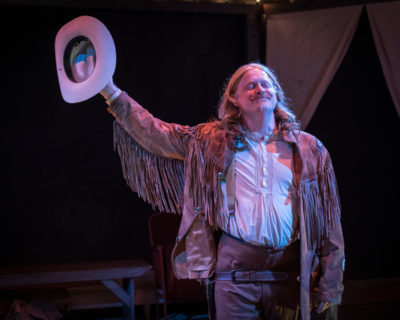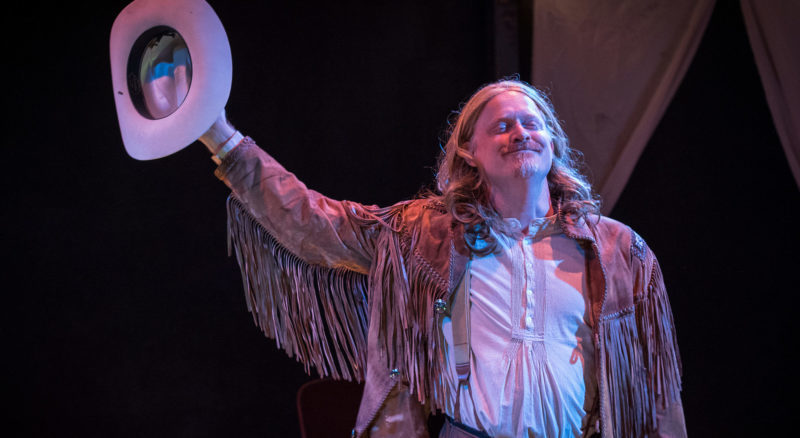INTERVIEW: Finding new meaning in Arthur Kopit’s ‘Indians’ at Metropolitan Playhouse

The Metropolitan Playhouse has searched back in the archives for an interesting play that could speak to the divisive society that the United States and world community are currently enduring. They settled on Arthur Kopit’s acclaimed Indians, a play about the 19th century settlement of western North America by European expansionists.
The theater company, under the artistic direction of Alex Roe, continues performances of Indians through this weekend on the Lower East Side of Manhattan.
The narrative is presented as a Wild West Show starring Buffalo Billy Cody. Kopit originally intended to offer commentary on the Vietnam War, while today, that commentary could include many of the political issues that dominate the headlines.
“I had had it on the shelf for a long time and actually not looked at it in quite a while, so I can’t say what made me pick it up again,” Roe said of his decision to stage Indians. “The company has a long history of revising American works from different eras that have been forgotten but that were at one point significant enough to be either extremely popular or in some way attention grabbing. Indians, of course, was nominated for the Pulitzer Prize and the Tony, and I had been interested in looking at plays from the ‘60s and ‘70s because I don’t know a lot about that era. You don’t see them done, but it’s such an interesting and fertile time for experiments in narrative and performance techniques.”
After he picked up the play, Roe was struck by how relevant and pertinent the themes are in 2017. One of the central ideas in Indians is how an individual, a community, a time period tells its historical story.
“[How] mainstream America tell ourselves the story of our history, of our rights, of our privilege, of our power and how easy it is for one group to self-identify as defined against anyone who is ‘other,’ be it another race, another nationality, another country simply,” Roe said. “And so with the assertion of a border wall, anti-Muslim rhetoric, the North Korean hostilities, as well as refugee questions, Black Lives Matter pushback … As we were beginning to do it, the Charlottesville rally had taken place, so questions of who we memorialize, how we memorialize and what our heroic figures represent to us were active, so all that’s going on. And then meanwhile thinking about the refugee crisis in Europe, the conflict between the government in Myanamar and the Rohingya, all the divisions in Syria, all these different world events and national events seem to be spoken to by this play from 1968, which was in many ways a response to Vietnam.”
Even though there are parallels to 2017, Roe’s direction of Kopit’s play doesn’t make the connections explicit. He wants the narrative to work its wonders without pushing too hard.
“A perfect example of where you might do this,” he said, “I think when I [think of] a figure of the president who is called in the program the Ol’ Time President, I think of him as a portrait of [Lyndon Johnson], this cowboy-hat-wearing figure equivocating over his responsibilities and his own reputation. Well, it would have been very easy to make him look like a [Donald] Trump figure now because a lot of the portrayal echoes that, but we didn’t go out of our way to do that at all. I think it’s clear enough, and I think it actually leaves a little room for the audience to enjoy making connections themselves without it imposed upon them by me or the production.”
The cast of the production dug deep into the themes of the play during the rehearsal process. Roe said they had a wonderful time becoming interested in the issues and exploring the characters. At the heart of their discussions was a central conceit: “respecting the theatrical histrionics of it on the one hand, being willing to be broad when they needed to be broad, and being very touching and intimate when they needed to be, but also trying to respect the portrayal of the Native American characters.”
He added: “I think one of the biggest challenges for the portrayal is in a play that is not a Native American play, and it’s not really about Native American culture, but rather about the co-opting and manipulation of Native American culture, we were all very concerned that we didn’t just off-handedly portray the Native American characters either disrespectfully nor over-reverentially … which is a patronizing portrayal in its own right.”
By John Soltes / Publisher / John@HollywoodSoapbox.com
Indians continues through Dec. 16 at the Metropolitan Playhouse in New York City. Click here for more information and tickets.

